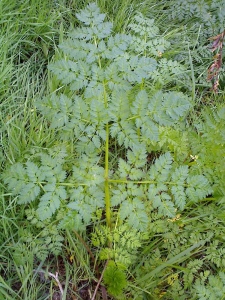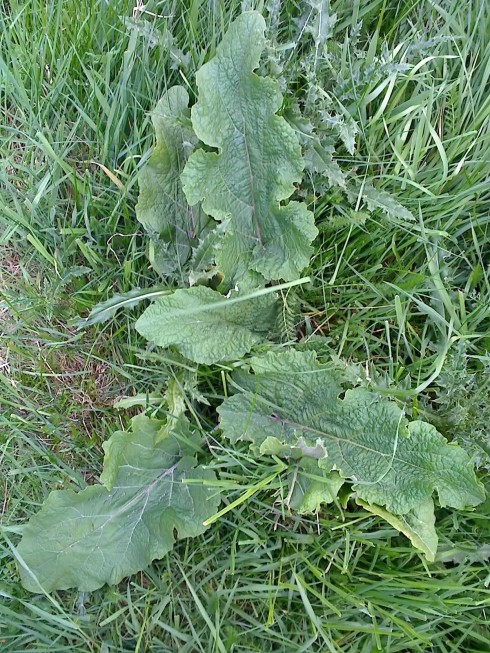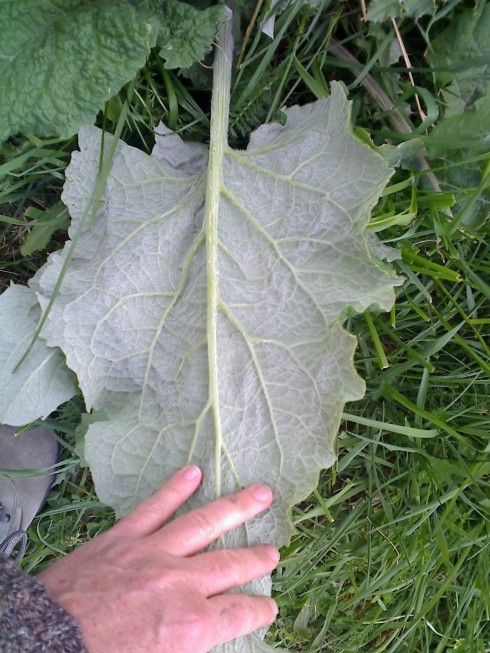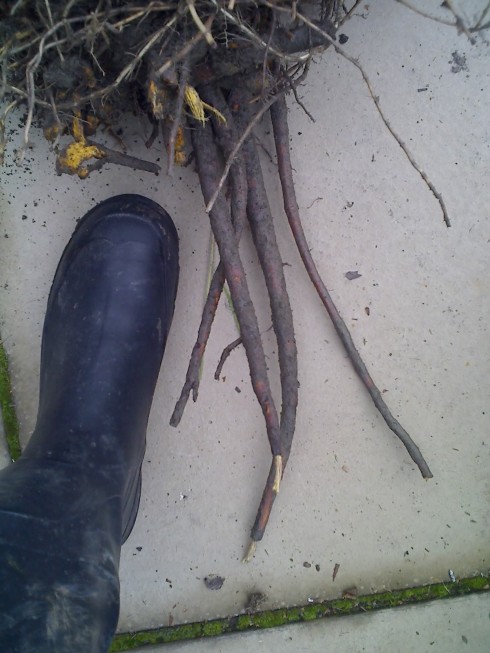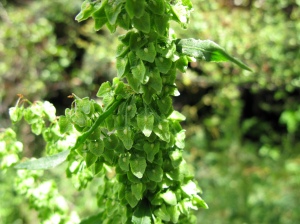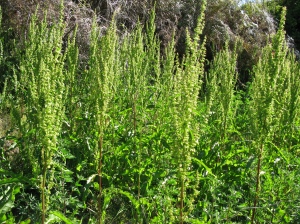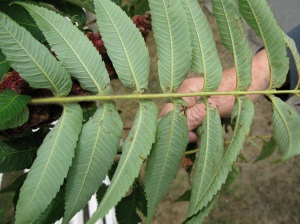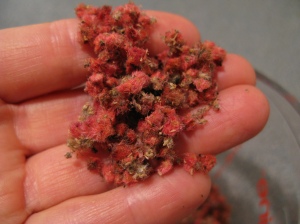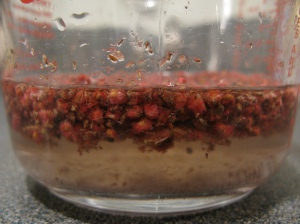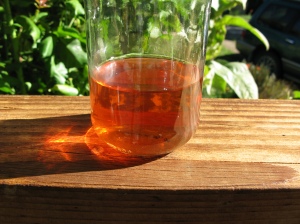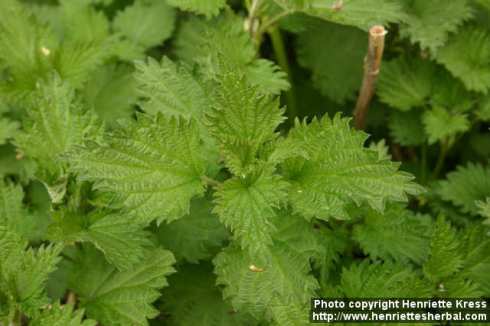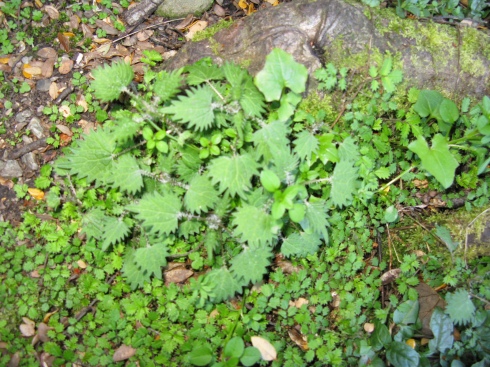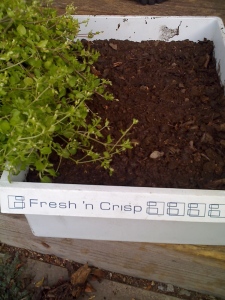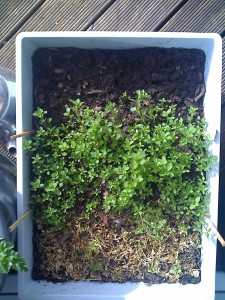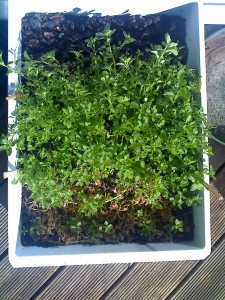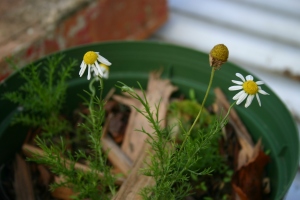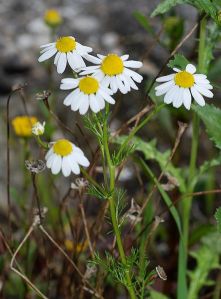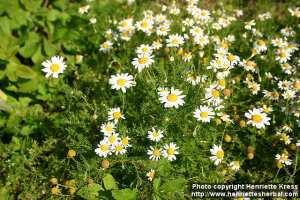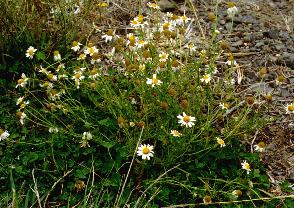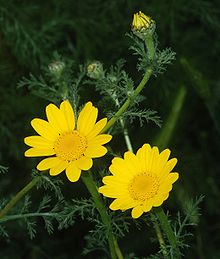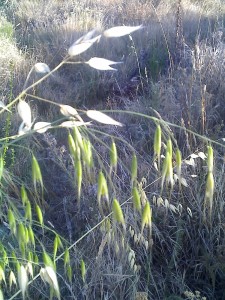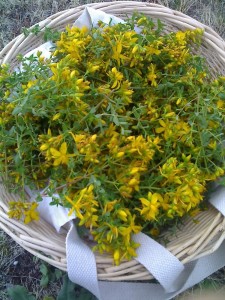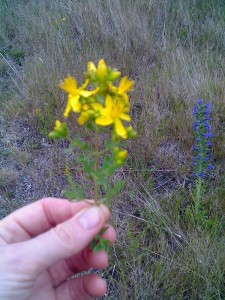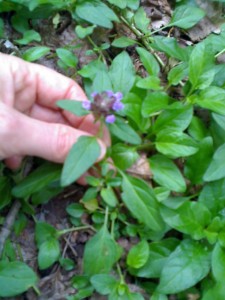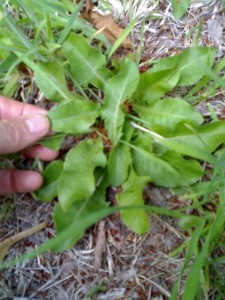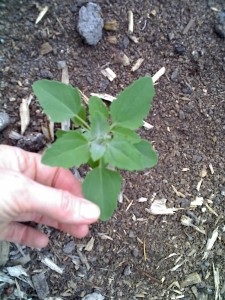You are currently browsing the category archive for the ‘ID’ category.
A friend was asking me about this while back. There’s a folk remedy for treating cancer called Essiac. It was made famous by a Canadian nurse, Rene Caisse, who reputedly got the recipe from an Ojibwa medicine man. There are various recipes for Essiac, all based on using four herbs: burdock root, sheep sorrel leaf, slippery elm bark, and turkey rhubarb roots. Woodstock herbalist Susun Weed investigated this formula and came to the conclusion that the original instructions had been altered – turkey rhubarb wasn’t native or naturalised in Canada, sheep sorrel has no reputation for healing cancer, and the slippery elm was probably there to counter the harsh effects of the turkey rhubarb on the digestive tract. Only burdock seemed to fit, with its long traditional use against cancer. She also heard that the original formula had two herbs in it, so she came to the conclusion that it was likely to be burdock and yellow dock roots (yellow dock is a relative of turkey rhubarb’s, also has a traditional use against cancer, and is much gentler on the system).
I’ve not had to deal with cancer in myself or helping others. Cancer treatments (conventional and alternative) can be contentious. I believe in respecting people’s right to make their own choices in health care and offer this post in that spirit.
I also believe that medicine should be cheap and easily accessible. To that end, here’s what burdock and yellow dock look like. Yellow dock is very common in most areas and can be harvested in quantity if necessary. Burdock is less common and is harder to dig up. If you need it in quantity it’s good to buy from a wholesaler. But it’s also good to have a direct relationship with any plant we use as medicine, and harvesting and preparing herbs is a good way to do that (not the only way though). It’s an good time of year to get to know and harvest both plants.
Note: the name ‘yellow dock’ isn’t commonly used in NZ except for when referring to herbal medicine. Mostly you’ll hear it called dock, or sometimes broad leaf dock and curly dock.
Burdock ID
Burdock, Arctium spp, is a biennial. This means it will put up leaves in the first year, and flowers and seeds in the second year and then it will die. If you want to harvest the root you need to harvest it before the plant starts to flower. Once it starts to flower, the plant uses the root energy for the flowering and seeding and by the end the root is spent.
Burdock leaves are large and look a bit like a furry rhubarb (although they’re not related). They have a large midrib and prominent veins. This isn’t the best photo, as most of the leaves are wrinkly, but the one in the bottom left corner is more typical:
If you turn a leaf over you will see that it is covered in white down. This down is on the stalks as well and is a key to identifying burdock. Also, look closely at the lower ends of the stalk (closest to where it is growing from) and you’ll see a reddy colour.
The leaves grow from a single tap root which has a reputation for being difficult to dig. It’s good to use a garden fork, loosening the soil around and around the plant. You’ll need to dig down quite a way if you want to avoid breaking off the root in the ground. There are also side roots or the main root splits, so take your time and take care – it’s worth getting all the root as harvesting is killing the plant and the root won’t grow back.
The closest look alike I can think of is foxglove (Digitalis spp), which is poisonous. Not likely to be confused once you see them together, but if you are new to IDing herbs then please use a good ID book or wildcrafter to help you with the ID.
Yellow Dock ID
Yellow dock, Rumex spp, is a perennial, meaning it grows back every year from the same root. It’s another large leafed herb, not as big as burdock generally, and the leaves are darker green and smooth rather than hairy.
There are two main docks in NZ – curly leafed dock (Rumex crispus)
and broad leafed dock (Rumex obtusifolius).
You can use them interchangeably for medicine or food. Broad dock is usually the more common. Both seem to like damp places (river beds, damp ground) but will grow on other places too. In a dry climate, the best places to look are where there is shade or damp, but in wetter climates dock grows everywhere.
Dock leaves grow from a crown above a root cluster that gets bigger with each successive year. Older plants yield more root and better medicine, and will have multiple tap roots. Because root harvest is best done in the late autumn or winter, when the leave have died back and the energy of the plant is focussed below ground, it’s good to find where your yellow dock grows earlier in the season so it’s easier to find when the tops have died back.
And the roots are indeed yellow (inside):
If you want to find yellow dock now for harvesting look for the seed heads. These are photos from the summer – the seeds now will be dried off and brown.
I’ll try and get some better photos this week but in the meantime there’s a good shot of autumn dock seeds here.
The Wessiac recipe can be found here. Both burdock and yellow dock can be used in lots of other ways as medicine or food.
I picked this up from the US herbalists. Sumac is a small tree that’s often planted in NZ gardens for ornamental value. It has distinctive red flower/fruit heads that last on the tree well after all the leaves have dropped. The trunk and branches are elegant, lending to the sculptural look.
This sumac is also known as staghorn sumac, Rhus thyphina, which helps differentiate it from related poisonous species*. The best way to ID sumac is by the ‘berries’. It took me a while to be sure that I had the right plant because sumac berries aren’t very berry like. Instead they are a horn-shaped cluster of small, red, furry bits:
I still haven’t found out if those are flowers, fruit or seeds, but the Americans call them berries.
The leaves are quite distinctive too, being obviously symmetrical:
Additional ID keys are the furry stems, and when you break them they ooze a white substance.
*If you read US sources of information about this plant there are cautions about not confusing it with poisonous sumac (a related plant). I don’t think this is an issue in NZ because (a) the poisonous sumac is rare (not sure if it even exists in NZ), and (b) it doesn’t look like staghorn sumac – poison sumac has drooping white berry clusters, not upright red ones. The leaves also look different.
Sumac Lemonade
Once you are sure you have the right plant, pick a few heads. It’s best to not pick straight after a rain, as rain washes off some of the tasty bits.
Pull the seeds off and put into a container.
Cover with cold water (yes, cold. Hot water makes the brew too strong) and squash the seeds a bit into the water.
I left mine overnight which made a very strong brew too, which I watered down. Subsequent batches I’ve made with 1 seed head to 2 cups of cold water, steeped up to an hour. Play around and see what works for you. When ready, strain the brew well to remove the fine hairs and bits of seed.
The taste of sumac is refreshingly sour and astringent. You can add honey or sugar if you like, but I’ve been happy drinking it as is. Drink a small amount the first few times to see how your body reacts – sumac is also medicinal and can make you pee more. I didn’t notice anything obvious and have been enjoying a glassful at a time.
You can dry sumac heads for later use (infusion or spice).
Things I want to try:
~ a longer infusion for maximum vitamin C extraction
~ a sumac berry vinegar (‘cos I have to try most things in a vinegar)
~ sumac as a dry spice (sumac is a traditional middle Eastern spice. A local forager told me to mix ground sumac, thyme and salt).
~ sumac honey
~ sumac and berries or other seasonal fruit (there’s a local company making sumac and plum relish).
Sumac resources
Matt Wood discusses on video different species of sumac, its use as a spice, and as medicine.
Susun Weed video on Euell Gibbons’ washing machine method for large batches of sumac lemonade!
I’m currently reacquainting myself with stinging nettle. For many years I made nettle leaf infusions, and then my body and tastes changed and I haven’t used it for a long time. Now with the wet spring there are nettles everywhere I go, so it’s hard not to be thinking about medicine again. I’ll do some posts about nettle as food and medicine, but first I want to talk about the plants themselves.
We have a handful of nettle species here in NZ, most are native and several are introduced.
native:
Urtica ferox, ongaonga, tree nettle: endemic (grows only in NZ).
Urtica incisa, dwarf bush nettle, scrub nettle: non-endemic (grows in Australia too).
Urtica linearifolia, swamp nettle: endemic.
Urtica aspera, grows in the South Island: endemic, rare.
Urtica australis (aka U aucklandica) ongaonga/okaoka, onga, taraongaonga, taraonga (I’m guessing the number of Maori names is due to the mix of Northern, Southern and Chatham Island dialects), Southern nettle: endemic, rare, found in coastal Fiordland, Stewart Island, the Chathams and the sub-Antarctics. Originally grew as far north as the bottom of the North Island (probably).
introduced:
Urtica urens, stinging nettle, small nettle, nettle: common throughout most of NZ, but uncommon in places (West Coast, Fordland, Taranaki, North Auckland).
Urtica dioica and subsp gracilis, stinging nettle, perennial nettle, tall nettle: uncommon.
Urtica membranacea, a Mediterranean nettle: I’ve not seen it but it’s listed as naturalised in Canterbury at least.
I’m going to write about the most common species. Nettles are plants of the disturbed ground. They grow in places where the soil has been bared, and so are common along roadsides, tracks and where land is overgrazed or otherwise cleared. Nettles love nitrogen and grow in places where the nitrogen is very high eg animal manure. I suspect that nettles play a crucial role in breaking down animal manure in places where the soil is marginal and struggling to re-establish other plants.
Nettles are most notable to the general public for the hairs on leaves and stalks that sting, sometimes quite painfully. Nettles are good medicine and food (being very dense in nutrients), and are useful in the garden and for fibre. As such they are another important plant to know well in preparing for the powerdown/post peak oil future.
Urtica urens is our most common weed nettle and was introduced in the 1800s, most likely from the UK (first recorded in NZ in 1860). It’s an annual, grows in disturbed soils, and seems to especially like sheep shit. I find it most often under and around stands of trees that sheep like to shelter under (manuka, kanuka, pine etc) but it will also sometimes grow in the open where the rabbits have been digging or where the soil has been disturbed in another way. My ex-neighbour always had a great crop of annual nettles in her garden because of the chicken manure and digging. Unlike some of the other nettles, urens has an affinity for dry ground.
Urens will often grow on a single stalk, but it can also grow multiple stalks and fan out into a small bush. It is a darker green than the other nettles (getting darker as it ages) and has a more rounded and textured leaf than the perennial. It’s sting is less painful than the perennial nettle but it has more stings and on both sides of the leaf (as well as the stalk). Most of the references you see to nettle as a medicine and food are not to this plant (more on that in a later post). They’re to its sister the perennial nettle:
Urtica dioica, a perennial nettle, was also introduced in the 1800s. It’s uncommon enough in NZ that I’ve never seen it growing wild, despite looking hard. In the US people talk about it growing near water. It has a pointier leaf than the annual nettle and looks similar to lemon balm in shape.
Unlike the annual, the stings on the perennial are predominantly on the top of the leaf, which is why some daring folk will eat them raw.
It’s considered a pest plant in NZ (what used to be called a noxious weed), mainly because its strong, spreading root structure can be difficult to contain once established. In some parts of NZ it’s illegal to distribute any part of this plant, so be careful, eh? If you want to grow it best to plant it somewhere reasonably contained like you would mint.
Urtica ferox, aka ongaonga/tree nettle, is one staunch plant. This native is large – up to several metres high, and grows in the bush, especially along margins of river and roads or in clearings. It also grows on farm land, having that same affinity for sheep shit and cleared land, but unlike the annual nettle (Urens) it often grows well out in the open.
The sting of this native is so strong that bad enough exposure can kill horses (eg where horses have been ridden through a stand of ongaonga. Humans too, but that’s incredibly rare. The sting is much worse than ordinary stinging nettle, and contact from even a single hair can be very painful for hours.
Urtica incisa and Urtica australis both have the potential to be useful as medicine if cultivated or reintroduced into native or non-native ecosystems and gardens. The seed of both those native nettles is available on Trade Me if you want to try them out, and the plants are available from Oratia Native Plant Nursery (as well as ongaonga).
Incisa I’ve seen in the bush and it’s always quite small so I’ve chosen not to harvest it (better to leave it for the bush anyway), but it would probably grow bigger in a garden (descriptions of the plant in Australia are much bigger than the ones here). I always see it growing near creeks so it’s one of the wet footed nettles.
The Chatham Island nettle (U australis) in particular looks interesting with its large heart shaped leaves (one report says they’ll grow as large as a lunch plate). It’s a perennial which means you can harvest the plant and it will regrow another crop. I don’t know how bad its sting is but online sources suggest its milder than most nettles.
All the nettles are becoming popular in NZ gardens because nettle is a prime food for the caterpillar of the Monarch and Red Admiral/kahukura butterflies.
I’ve gotten into the bad habit of starting to write posts and not getting them finished. Here’s one I started in the winter and am adapting to the spring.
I’m talking about chickweed ;-)
Some people think chickweed’s a nuisance, but really this is such a superb food and medicine that not only do I encourage it in my garden, I am also this year growing some in a pot. Chickweed is one of those plants that responds to being eaten by growing back lushly as quickly as possible. So if you cut it with a pair of scissors, then you will get another crop, and another etc until it manages to go to seed before you get to it. But once it seeds you can start again. Very lucky people have abundant chickweed in their garden, and can harvest most of the year. If you grow miner’s lettuce as well you can replace regular lettuce entirely for many months of the year, and be getting much better nutrition (chickweed is much more densely nutritious than lettuce).
Chickweed ID
Chickweed is a low growing annual, most notable in moist, damp places. There aren’t too many plants it can be mistaken for, mostly the mouse ear chickweed which is furry. Here’s an excellent photo of the edible chickweed, with ID labels from Wildman Steve Brill:
There’s no seed in that picture, but the seed capsules look similar to the ovoid flower buds.
Growing Chickweed
You need some seed. The easiest way to get this is off a late growth plant. Chickweed seeds quite quickly after flowering and usually has flowers and seeds at the same time. Here’s some chickweed that is flowering and seeding. It’s a bit straggly especially on the ends, and the stalks are more visible at this stage. If you open up one of the small capsules you’ll find an orange seed in side.
If you want to save some seed, put the whole above ground plant in a plastic bag and store it in the fridge. If there’s lots of seed it will drop out into the bottom of the bag. The last time I tried this, it didn’t work (there wasn’t much seeding, and maybe it was too early), but impressively the plant itself lasted a good month in the fridge and then when I put it out at the back door it started growing again.
But if you have seeding plants, you don’t need to remove the seeds individually, you can just use the whole top of the plant to grow some more.
I often get chickweed growing in pot plants (because I use garden soil in my potting mix) but if you don’t have any in your garden already you can usually find it in the wild.
I’ve not grown it intentionally in a pot before, so here’s my trial system. I got an old fridge box from the recycle centre. Because it was mid winter I kept this on the porch, and so I didn’t drill any holes in it. I’ve been keeping an eye on the watering so it doesn’t get waterlogged but chickweed does like a moist situation (and shady in the summer, it doesn’t like to get too hot). I filled the box with some soil and compost, and divided it into three sections:
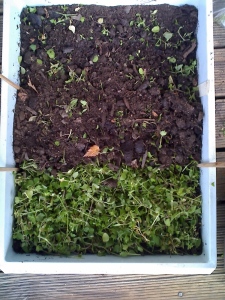 The bottom one is a layer of chopped, seeding chickweed. The middle is the same, but with a layer of soil on top. The top one is empty (despite a few leaves). Originally I was going to sow this with seed from the fridge, but it’s ended up being the ‘control’. If I’m really lucky I’ll get some interesting other salad weeds appearing in a timely fashion. I planted this out at the start of June.
The bottom one is a layer of chopped, seeding chickweed. The middle is the same, but with a layer of soil on top. The top one is empty (despite a few leaves). Originally I was going to sow this with seed from the fridge, but it’s ended up being the ‘control’. If I’m really lucky I’ll get some interesting other salad weeds appearing in a timely fashion. I planted this out at the start of June.
8 weeks later and it looks like this:
And at another 2 weeks later, ready to eat:
As you can see, the middle section, which was chopped seeding chickweed covered in soil, has done the best. The bottom section, where the chopped weed was uncovered is only just starting to grow, and the top section (nothing sown in it) has nothing growing in it (damn, but I might get lucky with the longer days and spring arriving).
That was quite slow for chickweed, being over the coldest months. Inside I’m sure it would grow faster. In less cold places, I’ve grown and eaten chickweed during the winter, spring and autumn. If you want to in the summer you need somewhere shady and moist.
The chickweed is now growing fast and is covering 2/3rds of the box. I can harvest about twice a week. I’ve been watering and feeding occasionally with worm whisky.
Chickweed as food and medicine
Chickweed is at its best raw. Use abundantly in salads, or chop onto grain dishes as a garnish. Chickweed pesto is famous on weedy circles. Johanna Knox has some other great ideas about eating chickweed.
The taste of chickweed varies a bit, maybe because it has so much water in it that it’s more affected by growing conditions. Generally it is bland, slightly salty and fresh with a slight bitter taste at the end – basically a standard green. When it’s older it gets stronger.
It has pretty decent amounts of minerals and vitamins, making it a good food for increasing nutrients in the diet. It also has a range of medicinal offerings and is especially good at cooling overheated conditions. Chickweed extracts well into alcohol (for medicine), vinegar (for nutrition), oil (for external use) and spit (also for external use but ingesting is good too).
I’ve always found the different chamomiles a bit confusing, mainly because I’ve not grown it enough myself to make the connection, and the dried herb on sale in shops is not usually identified by species. This post is my attempt to get them clear in my head. Input from anyone familiar with the plants is welcome.
A friend once gave me some dried flowers she had collected from her own plants and it made the most amazing tea. I only needed four or five flowers per cup of water, and the taste was better than any commercial chamomile I’ve had. So I’ve been on a bit of a mission to find out which chamomile it was. As it turns out the chamomiles have a confusing array of names and synonyms so it’s not just me. I’ve finally decided my friend’s tea is the German chamomile, but it wouldn’t surprise me if it’s not.
This is the plant:
The chamomiles are part of the Asteraceae family, which is a large family of plants with daisy-like flowers – a composite centre (the family is also called Compositae) with petals around the edge. Botanically the flowers are actually the many minute parts that make up the often yellow composite centre.
There are two main genera of chamomile: Matricaria and Anthemis. Common names in this post are the ones used in NZ references unless noted otherwise. Common names vary from country to country and even within a country – botanists, farmers, academics and herbalists can all use common names differently – so it’s always best to ID a plant by the botanical name of genus and species. Having said that, the chamomiles seem to have more than their fair share of botanical synonyms as well.
I haven’t had the chance to try this yet, but Weeds of Crops and Gardens in NZ (p 97) has this to say on the differences in the flowers between the two genera:
As with all Anthemis spp, the bristles remain on the centre after the rest has been rubbed away, whereas in all the Matricaria spp no bristles remain.
Matricaria spp
Matricaria recutita (aka M chamomilla, M suaveolens, Chamomilla chamomilla, and C recutita): German chamomile. This is an annual native to Europe and the temperate parts of Asia. It is naturalised in some places in NZ although I’ve not seen it growing wild. More commonly it’s grown as a garden herb.
Matricaria dioscoidea (aka Matricaria matricarioides, sometimes mistakenly called M discoidea): Rayless chamomile, also an annual it smells a bit like pineapple (and in some parts of the world is known as pineapple weed). According to Henriette Kress it can be used like the more well known medicinal chamomiles (both the leaf and flower). This is fortunate for us as rayless chamomile is well naturalised in NZ. ID keys are here.

rayless chamomile ~ http://www.missouriplants.com
Tripleurospermum inodorum (aka Matricaria maritima and M perforata): Scentless mayweed/scentless chamomile. Looks similar to Anthemis cotula (see below).
Matricaria inodora (scentless chamomile), and Matricaria suaveolens are illegitimate names.
Anthemis spp
Anthemis nobilis (aka Chamaemelum nobile) Lawn chamomile, Roman chamomile: a perennial, this is the chamomile grown for a ground cover. The medicinal herb does flower, but I gather there is a hybrid that has no flowers.
Anthemis arvensis – corn chamomile.
Anthemis cotula – stinking mayweed, stinking chamomile, mayweed. Less common in Canterbury, Otago and Southland. ID here.
Anthemis tinctoria – dyer’s chamomile
Anthemis mixta – invalid name.
Anthemis cupaniana – synonym Anthemis punctata subsp. cupaniana
I’m looking forward to things growing again and going out to hunt down the rayless chamomile.
As often happens, and one of the things I love about wildcrafting is that I go out to look for one thing and I find something else entirely. This time it was a cluster of oat plants going to seed. I’ve grown oats before, but rarely seen them growing wild, so I was pretty excited.
Oat plants are Avena species. In NZ no-one seems to talk about varieties, so I’ve never been sure what oats we have here. I’m guessing the ones I found grew because someone had dumped some seed there (it’s a well known spot for dumping garden waste). I guess birds could have brought the seed in too. Either way, it’s likely that it’s seed from commercially grown plants. I don’t see much oat growing wild (although admittedly it’s hard to spot before it seeds).
Identifying Oat plants
Like other grains, oat plants have three obvious structural parts: the stems, the leaves and the grain. The stems of oat are notably round and hollow – the straw of oatstraw. The leaves look like large blades of grass (hence the difficulty recognising them before they seed).
The seeds hang from a thin stalk that grows out from the main stem.
They are covered in an outer husk that separates off as the seed matures – you can see the empty ones at the top of that photo. Inside the green double husk is the oat proper. For medicine you want the oatseed when it is ‘milky’ – the seed is ripe but not dried and when you squeeze it you get a milky liquid. This is why some oat medicines are known as milky oats, to distinguish from other parts of the plant, or seed harvested later. Seed for making porridge is harvested after the milky stage, when it has matured and dried.
The seeds have a beautiful green and white stripe pattern to them:

photo by http://www.atlas-roslin.pl/
Farmers seem to plant one oat crop a year, harvesting late summer I think. I found oat pretty easy to grow, even sowing later in the season. Oat is also used as a manure crop in gardening (planted in early spring or late autumn), so you could harvest the milky oats, and even some of the oatstraw, and then dig in the remaining plant. I’m not sure if whole oats from a store will sprout as the hull has been removed. But you can get oats for sowing in many places including organic stores. Koanga have an old variety hull-less oat for growing the grain, and Kings are selling Avena sativa seed specifically as a cover crop.
Oat medicine
Oat is a superb nerve nourishing herb – it is both nutritive and healing.
US wise woman herbalist Susun Weed devotes a whole chapter to it in her book Healing Wise. She recommends taking it as an infusion (using the dried oatstraw) to access the abundant stores of minerals, especially calcium and silicon.
Other North American herbalists rave about milky oat tincture for its ability to strengthen nerve function, promote relaxation and relieve stress.
Oat also works on the hormonal systems, and is a lovely cosmetic and skin healer. If you don’t have access to oatstraw or milky oat tincture, then eating the oats themselves is also highly beneficial. You get the abundant minerals as well as the nerve strengthening properties.
I’ve use oat mainly as an infusion, and of course as porridge. It’s one of the mainstays of my health.
A word about oatstraw for sale in NZ. Oatstraw is sold in two grades: green and gold. Green is harvested when the plant is still vibrant and growing and the seed is milky. The dried herb should reflect this – there will be a green and light gold colour in the cut herb, and it will smell clean. It includes the whole above ground plant so there should be some seed in it as well as leaf and stalk before they’ve browned off. If everything is brown then it’s not green oatstraw even if the seed is there (they’ve just left it too late to harvest).
Gold oatstraw is the leaf and stalk harvested later, usually after the grain has been taken off. Theoretically it should be possible to harvest this well, but in NZ all the gold I’ve come across smells and tastes bad. I suspect it’s because the oatstraw is harvested after the grain has been cut, but it hasn’t been looked after well. Herbs need to be processed to dry as soon as possible after harvesting to retain the freshness. Gold oatstraw comes across as a leftover byproduct of the oatmeal industry. It’s cheaper because of this, but not worth the bother in my opinion. It may taste ok in blends or even as a tea, but made into an infusion it tastes like you’re drinking brewed grass clippings. A part of this will be because of the difference in chemistry once the plant has dried off before harvesting, but some of it seems lack of care in drying and storing.
Don’t buy oastraw that smells musty or mouldy.
St John’s wort, Hypericum perforatum, is a weed of the dry and broken lands. It grows commonly on disturbed and/or degraded land, usually where it is stoney or gravelly or otherwise dry. You often see it along river beds or it appears the year after a new track or road is put in. It also grows extensively on overgrazed land. If you haven’t seen any locally yet look along river beds, in old gravel pits, new tracks or where there’s been any disturbance to the soil.
SJW reproduces by seed, which it produces copiously each year. Once it gets established in an area it tends to spread. I’ve been watching it expand its territory over the past 15 years. In Central it grows everywhere north of Cromwell, and in more select places and along roadsides as far south as Lawrence. It’s in Queenstown, making it’s way into Northern Southland. It grows in river beds and on roadsides in Fiordland (where it first turned up in tourist car parks, presumably having hitched a ride from Queenstown). It’s in places along the east coast where it’s dry (haven’t seen it in Dunedin environs, yet) – it’s in at least some of the east draining rivers.
I’d love to know where it grows in North Canterbury, Nelson/Marlborough and the West Coast, and the North Island.
In some places in Central it’s everywhere. Other places outside of Central it’s more localised, but it’s worth having a good scout around in likely places because it’s still getting naturalised and so hasn’t fully extended its range i.e. it might not be obvious but still there.
Farmers don’t like SJW because it can cause photosensitivity in stock (cattle at least) and a beetle was introduced to try and control it but doesn’t seem particularly effective. There’s a whole lot of bother about SJW causing photosensitivity in humans, but in fact that is rare and seems to be associated with commercial preparations (more on this in the SJW uses post).
SJW is a perennial (meaning it grows back each year from the same plant) but in some ways behaves like an annual – it seeds prolifically and its communities seem to move around a bit. Often a really good patch one year will be absent the following year.
There aren’t too many look alikes to confuse this with (ragwort, Senecio sp, from a distance, which overlaps its flowering with SJW), but here are some keys:
1. flowers are bright yellow and have 5 petals with a tufty centre, and are less than 2cm across.
2. branches and leaves are in opposite pairs.
3. leaves have oil glands, either clear or black, and visible when held up to the light. When crushed these stain the fingers red.
4. flowers also stain the fingers red when crushed.
5. it grows from a central point or clump in the ground and can be a single stalk a couple of inches high up to a largish bush of a metre.
There are other Hypericums in NZ. Tutsan, Hypericum androsaemum, is a garden shrub, but has obviously larger flowers and leaves, no discernible oil glands and generally isn’t considered medicinal because of this (it may have other medicinal properties). There are several native Hypericums, including two that are endemic (they only grow here). I don’t know if the native Hypericums are medicinal but they are rare enough to warrant not harvesting them (especially as the introduced SJW is so common).
I harvest the flowering tops of SJW (including leaves and stalk) for tincture and the flowers for oil. This is an almost perfect sample of what I like to make tincture from. A mixture of flowers and buds with some leaves and stalk, but not really any seed yet. It’s also ok to harvest older plants that have some new seedheads as long as the flowers and buds predominate.
If I was picking for oil I would take most of the top cluster of flowers with as little stalk as easily possible (don’t have to be too pedantic about it), leaving some of the lower buds to eventually produce seed.
Here’s the jar filled with the chopped herb from the basket at the top of the post.
I then filled the jar again, with 50% alcohol, capped it and will let it sit for at least six weeks before decanting.
SJW is famous for going a delicious and intense red as soon as you pour in the alcohol (this photo doesn’t do it justice). Oil takes longer but eventually goes a red colour too.
SJW usually flowers for a month or more. Some years it starts in mid December, but mostly I’ve harvested in January, sometimes even into mid February. It’s still going strong at the moment, some plants are starting to put out seedheads but there are still many in bud and flower. I’m going to make some more oil this week.
I’ve been craving greens this week so have been out looking for the summer weeds. Here’s what I found on my weed walk today. Most of these plants were growing wild.
Self heal, Prunella vulgaris. A low growing perennial, found in shady or damp-ish places. A member of the Lamiaceae family that includes mint. All members of this family have square stems and leaves opposite in pairs. This photo is a bit confusing because there is another plant there that looks very similar but with shinier leaves (self heal has matt leaves). I need to go back and find out what it is. This is a good instruction in paying attention and being certain that what you are picking is what you think you are picking. Unlike many others of the mint family self heal has no volatile oil. Tastes bland with a subtle pungency (that is stronger in wetter places I think).
Watercress, used to be Rorippa sp now Nasturtium sp (probably N microphyllum). Only very distantly related to the garden nasturtiums. Introduced from Eurasia, there are two species in NZ. Watercress grows mainly in streams with moving water, occasionally in boggy places. Most of this patch is flowering with long thin seed heads rather than leaves, but I manage to find a small handful of green shoots. A member of the cabbage family (Cruciferae, because the flowers always form a cross pattern), it is pungent and hot to taste.
Mallow, Malva sp. One of the smaller mallows, just about to flower. The leaves contain mucilage, which makes it cooling and moistening medicinally and food-wise. It’s related to the marshmallow and has similar uses herbally. The taste is bland.
Dandelion, Taraxacum officinale. Grows everywhere. Needs to be identified to distinguish from lookalikes. Young leaves that have come up after being mown I think. Or maybe first year leaves. Either way, bitter taste but not too bitter. Older leaves would be more bitter and so best to use less of them.
Plantain/kopakopa, Plantago major. Smallish, gnarly plants from another patch of mown grass, but still lush. Notable for their five or more distinct ribs with a thread inside when broken open at the stalk. There are two species in NZ, this one and another that has long thin leaves (P lanceolata). The narrow leafed one isn’t that great as a food, but both medicinal. Taste is green.
Fathen, Chenopodium sp, probably C album. A relative of spinach, quinoa and amaranth. It’s been a traditional food in both the Americas and Europe. This is a young plant – adults can grow up to a metre when seeding. It’s a common first arrival in new soils and grows prolifically, so if you like the taste it’s worth letting it seed in the garden (it’s not hard to weed out from places you don’t want it). Taste when young is bland, tarter when older.
Sheep’s sorrel, Rumex acetosella. One of the docks, a small, usually low growing one. It has a distinct double ‘tag’ at the bottom of each leaf. With a similar tartness as the docks but more lemony (like garden sorrel) and suitable for eating raw.
Want more? Check out Joanna Knox’s Wild Picnic blog and her wild food posts on Star Cooked.
It’s still a good time to be harvesting mullein, so here’s a post on IDing this plant.
Mullein is a darling of the dry lands. It grows in dry, stony, well draining, usually disturbed soils, and self seeds readily making it abundant once established. It’s a biennial, growing for two years before it dies. It flowers in the second year in the summer, each plant sending up a tall spike that eventually turns into a seed stalk. I’ve seen a mullein flower stalk grow above the height of roof guttering, but mostly they’re up to shoulder height.
If you’re not sure where to look for them, try a river bed that is stony or dry. Farm paddocks often have mullein in them in drier climates too. Mullein grows all through Central, along the east coast at least as far south as Dunedin, and I’d guess it’s in the upper parts of the Southland rivers. It’s also in Fiordland though not so abundantly. I can’t imagine it doesn’t grow in Nelson and North Canty. Don’t know about the West Coast and up North but it’s such a common plant that it’d be worth looking around.
There are two main mulleins in NZ: Wooly mullein (Verbascum thapsus), and Moth Mullein (V virgatum). Both are medicinal. I’ve not used moth mullein, but its flowers are commonly used to make an infused oil to heal ear ache. Wooly mullein is a superb lung healing herb.
Wooly mullein has grey green leaves that are wooly. It has a distinctive rib on the back of the leaf, and they grow in rosettes, initially at ground level and then rising up when the plant sends up its flower stalk in the second year. Plants can range in size from small (hand sized) to massive (leaves reaching up to half a metre long). Smaller plants are found in drier spots, and the massive ones in places with good amounts of water.
A typical wooly mullein plant, early second year:
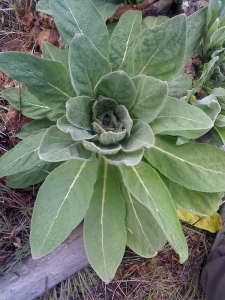
Old seed stalks from last year. Note the seed capsules (which contained many small seeds) are crowded on the stalks (see the top third of the stalk on the right), and the new plants in the foreground:
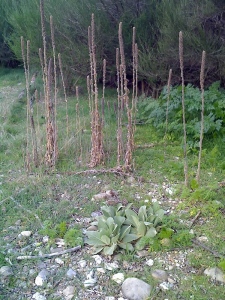
Moth mullein has much greener leaves. They’re not wooly but are textured with wavy margins. They also grow in rosettes, but don’t get very big – in a wet spring like this one you might find bigger plants, but mostly they are up to a handspan wide.
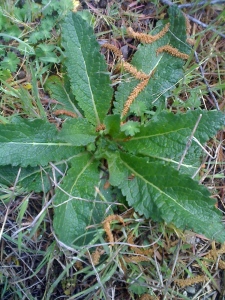
This plant looks a bit like foxglove (poisonous) and some other low growing weeds, so please use a good identification guide if you are harvesting it for medicine.
Moth mullein seed stalks showing the seed capsules more sparse than wooly mullein:
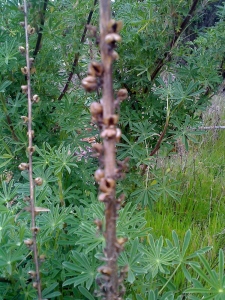
I like this plant. But it can be very poisonous, and looks like some other plants that aren’t poisonous and are edible so I thought I’d do an ID post.
Please read this post on IDing plants safely.
Hemlock, Conium maculatum, is a biennial of the Umbelliferae family. That family has a wide range of edible plants including carrot, fennel, and sweet cicely. Wild carrot and cicely in particular have leaves very similar to hemlock.
It can grow very tall (taller than me). Often you see the spent seed stalks amongst the new growth. It has feathery, fern-like leaves. There are two good ways to tell if it’s hemlock:
1. Hemlock has a distinctive smell, that to us smells ‘bad’ when crushed i.e. it’s stinky.
2. Hemlock has purple blotches on its stem (usually).
Because hemlock is so poisonous, it’s best to ID any similar looking plant two ways. Know how to recognise hemlock so you can exclude it, and know how to recognise each Umbelliferae you want to harvest i.e. don’t rely solely on looking at a plant and thinking it doesn’t have purple blotches on the stems therefore it must be edible. Go the next step and positively ID the plant you are looking at.
Young hemlock showing the stems with purple markings:
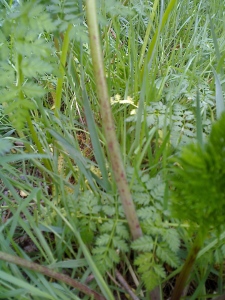
Hemlock leaf:
